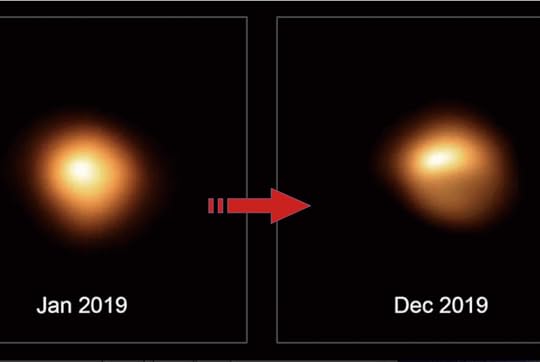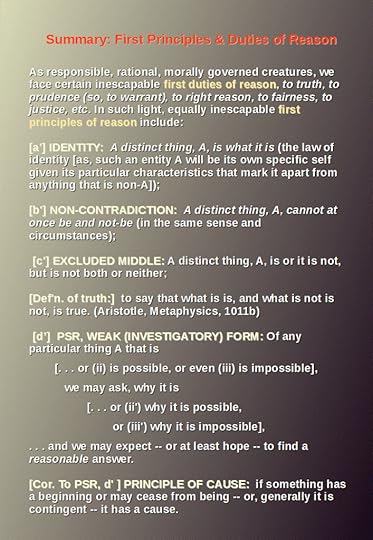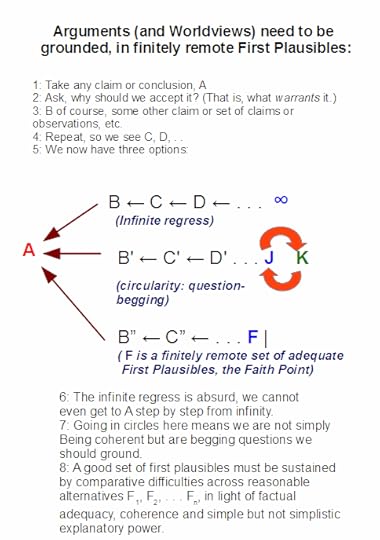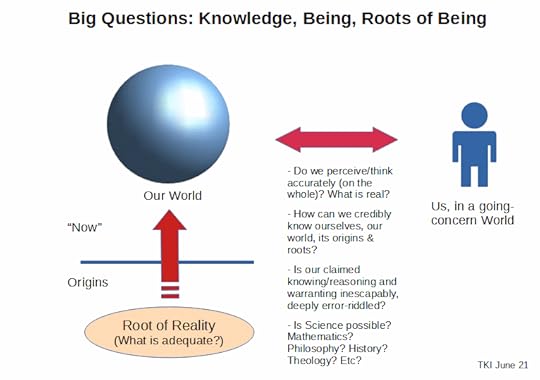Michael J. Behe's Blog, page 178
July 20, 2021
Science questions whose answers we may never get
Science writer Ross Pomeroy offers us four. Here’s one:
How Is Consciousness Created?
Philosophers and scientists have been grappling with consciousness for thousands of years. The discussions and explorations have been lively, but altogether unable to uncover how consciousness arises. According to Philip Goff, an assistant professor of philosophy at Durham University, there’s a simple reason for that.
“You can’t look inside someone’s head and see their feelings and experiences. If we were just going off what we can observe from a third-person perspective, we would have no grounds for postulating consciousness at all… The best scientists are able to do is to correlate unobservable experiences with observable processes, by scanning people’s brains and relying on their reports regarding their private conscious experiences.”
This is interesting, but doesn’t drive to the heart of the issue, Goff says.
“What we ultimately want is to explain why conscious experiences are correlated with brain activity.”
Right now, we have no clue how to do that.
Ross Pomeroy, “Four Scientific Questions We May Never Know the Answers To” at RealClearScience (July 19, 2021)
Part of the problem is that everyone is dealing from the same deck. No one has “super” consciousness. That must make a difference in understanding.
For more on Philip Goff, see Meet the serious panpsychists.
The rest of the article addresses qualia, the Big Bang, and black holes. All worth reading.
Copyright © 2021 Uncommon Descent . This Feed is for personal non-commercial use only. If you are not reading this material in your news aggregator, the site you are looking at is guilty of copyright infringement UNLESS EXPLICIT PERMISSION OTHERWISE HAS BEEN GIVEN. Please contact legal@uncommondescent.com so we can take legal action immediately.Plugin by Taragana
Is there an alternative to dark matter?
Physicist David Merritt offers one:
The standard theory of cosmology is called the Lambda cold dark matter (ΛCDM) model. As that name suggests, the theory postulates the existence of dark matter – a mysterious substance that (according to the theorists) comprises the bulk of the matter in the Universe. It is widely embraced. Every cosmologist working today was educated in the Standard Model tradition, and virtually all of them take the existence of dark matter for granted. In the words of the Nobel Prize winner P J E Peebles: ‘The evidence for the dark matter of the hot Big Bang cosmology is about as good as it gets in natural science.’
There is one problem, however. For four decades and counting, scientists have failed to detect the dark matter particles in terrestrial laboratories. You might think this would have generated some doubts about the standard cosmological model, but all indications are to the contrary. According to the 2014 edition of the prestigious Review of Particle Physics: ‘The concordance model [of cosmology] is now well established, and there seems little room left for any dramatic revision of this paradigm.’ Still, shouldn’t the lack of experimental confirmation at least give us pause?
In fact, there are competing cosmological theories, and not all of them contain dark matter. The most successful competitor is called modified Newtonian dynamics (MOND). Observations that are explained under the Standard Model by invoking dark matter are explained under MOND by postulating a modification to the theory of gravity. If scientists had confirmed the existence of the dark particles, there would be little motivation to explore such theories as MOND. But given the absence of any detections, the existence of a viable alternative theory that lacks dark matter invites us to ask: does dark matter really exist?
David Merritt, “A non-Standard model” at Aeon
See also:
Discover: Even the best dark matter theories are crumbling
Researcher: The search for dark matter has become a “quagmire of confirmation bias” So many research areas in science today are hitting hard barriers that it is reasonable to think that we are missing something.
Physicists devise test to find out if dark matter really exists
Largest particle detector draws a blank on dark matter
What if dark matter just doesn’t stick to the rules?
A proposed dark matter solution makes gravity an illusion
and
Proposed dark matter solution: “Gravity is not a fundamental governance of our universe, but a reaction to the makeup of a given environment.”
Copyright © 2021 Uncommon Descent . This Feed is for personal non-commercial use only. If you are not reading this material in your news aggregator, the site you are looking at is guilty of copyright infringement UNLESS EXPLICIT PERMISSION OTHERWISE HAS BEEN GIVEN. Please contact legal@uncommondescent.com so we can take legal action immediately.Plugin by Taragana
July 19, 2021
At MMN How an eccentric mathematician opened up the world
Science writer Ashutosh Jogalekar has written a wonderful essay that explains how Kurt Gödel (1906–1978) defeated crass materialism:
“So what had Gödel done? Budiansky’s treatment of Gödel’s proof is light, and I would recommend the 1950s classic “Gödel’s Proof” by Ernest Nagel and James Newman for a semi-popular treatment. Even today Gödel’s seminal paper is comprehensible in its entirety only to specialists in the field. But in a nutshell, what Gödel had found using an ingenious bit of self-referential mapping between numbers and mathematical statements was that any consistent mathematical system that could support the basic axioms of arithmetic as described in Russell and Whitehead’s work would always contain statements that were unprovable. This ingenious scheme included a way of encoding mathematical statements as numbers, allowing numbers to “talk about themselves”. What was worse and even more fascinating was that the axiomatic system of arithmetic would contain statements that were true, but whose truth could not be proven using the axioms of the system – Gödel thus showed that there would always be a statement G in this system which would, like the old Liar’s Paradox, say, “G is unprovable”. If G is true it then becomes unprovable by definition, but if G is false, then it would be provable, thus contradicting itself. Thus, the system would always contain ‘truths’ that are undecidable within the framework of the system. And lest one thought that you could then just expand the system and prove those truths within that new system, Gödel infuriatingly showed that the new system would contain its own unprovable truths, and ad infinitum. This is called the First Incompleteness Theorem. – Ashutosh Jogalekar, “Kurt Gödel’s Open World” at 3quarksdaily (July 12, 2021)”
The big materialist project was then formally over. Many people did not realize that fact and, in any event, it would take a long time to mop up. We are still mopping.
News, “How eccentric mathematician Kurt Gödel opened the world” at Mind Matters News
As often happens, few people understood the significance of what had just happened. The one exception was John von Neumann.
Takehome: The First Incompleteness Theorem means that the big materialists project is essentially already over. But it takes a long time to mop up.
You may also wish to read:
Gregory Chaitin’s “almost” meeting with Kurt Gödel: This hard-to-find anecdote gives some sense of the encouraging but eccentric math genius.
Copyright © 2021 Uncommon Descent . This Feed is for personal non-commercial use only. If you are not reading this material in your news aggregator, the site you are looking at is guilty of copyright infringement UNLESS EXPLICIT PERMISSION OTHERWISE HAS BEEN GIVEN. Please contact legal@uncommondescent.com so we can take legal action immediately.Plugin by Taragana
Researchers: Other mammals, not dinosaurs, kept our side down
Perhaps they were more efficient than dinosaurs? They knew their targets?
Dinosaurs so thoroughly dominated the ancient world that they suppressed the evolutionary possibilities open for mammals. This notion has been around for decades now, and it seems to be backed up by the fact that no known mammal became larger than badger-sized during the time dinosaurs were the most prominent animals on land. But, thanks to decades of new fossil discoveries, paleontologists have realized an important twist in the story—it wasn’t dinosaurs that suppressed the evolution of our ancient mammalian ancestors, but other forms of ancient mammal.
Paleontologists who study fossil mammals have suspected the story of “dinosaur dominance” was too simple, but, until now, the critical evidence was missing. Clues that the picture was more complicated now come from a new Current Biology paper by University of Oxford paleontologist Elsa Panciroli and colleagues that followed the evolutionary spread of various mammals during the Age of Dinosaurs—from more ancient types called mammaliaforms to the group of mammals found all around us today, the therians. Because the ancient mammaliaforms diversified and spread into so many forms first, the researchers found, our own mammalian ancestors and relatives didn’t have a chance to truly dig their claws into the world’s ecosystems until after the asteroid strike that sparked a mass extinction 66 million years ago.
Riley Black, “Other Mammals, Not Dinosaurs, Kept Our Ancestors Down” at Smithsonian Magazine
This would make a great documentary. Unfortunately, the paper at Current Biology is closed access.
Copyright © 2021 Uncommon Descent . This Feed is for personal non-commercial use only. If you are not reading this material in your news aggregator, the site you are looking at is guilty of copyright infringement UNLESS EXPLICIT PERMISSION OTHERWISE HAS BEEN GIVEN. Please contact legal@uncommondescent.com so we can take legal action immediately.Plugin by Taragana
L&FP, 47: The challenge of “proof” in a world of radical doubt and hyperskepticism
“Prove it . . .” is a familiar challenge, one, often strengthened to “unless you prove it I can disregard what you claim.” However, ever since Epictetus, c. 100 AD, it has met its match:
 Epictetus c 50 – 135 AD
Epictetus c 50 – 135 AD
DISCOURSES
CHAPTER XXV
When someone in [Epictetus’] audience said, Convince me that logic is necessary, he answered: Do you wish me to demonstrate this to you?—Yes.—Well, then, must I use a demonstrative argument?—And when the questioner had agreed to that, Epictetus asked him. How, then, will you know if I impose upon you?—As the man had no answer to give, Epictetus said: Do you see how you yourself admit that all this instruction is necessary, if, without it, you cannot so much as know whether it is necessary or not? [Notice, inescapable, thus self evidently true and antecedent to the inferential reasoning that provides deductive proofs and frameworks, including axiomatic systems and propositional calculus etc. Cf J. C. Wright]
Lesson one, there are unproven antecedents of proof, including the first principles of right reason, here especially laws of logic. In this case, if one tries to prove, one is already using them and if one tries to object one cannot but use them, so we sensibly accept them as self-evident, pervasive first principles.
As there are always those who need it, pardon a diagram that abstracts from a bright red ball A on a table, to help us recognise the first cluster of such principles:

Okay, okay, here is my actual example of a ball on the table:

And, here is one in the sky, for good measure, Betelgeuse, as it dimmed in 2019 . . . identity with change:

In for a penny, in for a pound. Let me suggest a partial but useful list of such principles of logic and wider right reason . . . and yes, this chart marks a stage in my understanding of Cicero’s point:

This is already a big hint on our limitations in reasoning. We may now bring to bear in effect the Agrippa trilemma, to see how chains of proof and wider warrant confront us with a triple challenge, leading to having to — usually, implicitly — accept finitely remote first plausibles:
 A summary of why we end up with foundations for our worldviews, whether or not we would phrase the matter that way}
A summary of why we end up with foundations for our worldviews, whether or not we would phrase the matter that way}We are already duly humbled.
It gets “worse.”
For, “proof” itself is a slippery concept. The very model is of course Euclidean Geometry, with its complex system of theorems — derived from, uh, ah, um, first claims, i.e. axioms. Which, in this case, were subjected to a huge debate and now Mathematical systems are often viewed as logic-game worlds constructed from frameworks of axioms we find interesting and/or useful.
Then, came Godel, and SEP is helpful:
Gödel’s two incompleteness theorems are among the most important results in modern logic, and have deep implications for various issues. They concern the limits of provability in formal axiomatic theories. The first incompleteness theorem states that in any consistent formal system F within which a certain amount of arithmetic can be carried out, there are statements of the language of F which can neither be proved nor disproved in F. According to the second incompleteness theorem, such a formal system cannot prove that the system itself is consistent (assuming it is indeed consistent). These results have had a great impact on the philosophy of mathematics and logic . . .
Proof, in the sense, accessibility from some reasonable, finite cluster of axioms, for systems of reasonable complexity, is thus different from truth. Truth, accurate description of states of affairs. (And BTW, practical axiomatisations typically are built to be compatible with recognised facts, some of which may be self-evident like || + ||| –> |||||.)
Already, we are in trouble. It gets deeper once we come to Science. As in, follow the Science, Science has proved etc. Next to me is a gift [thanks Aunt X], “Proving Einstein right.” Only, science is incapable of such strong-sense proof. We may empirically support theories as explanations through empirical evidence, but at most we can say our theories are plausible and may prove — test out — to be at least partly true but are subject to the limits of inductive thinking. That is, we face the pessimistic induction, that our explanations that seemed ever so plausible have historically consistently been sharply limited or outright wrong often enough to give us pause.
We already saw a weaker sense of to prove, to test with some rigor. Bullet proof, means, tested and found credibly resistant to certain specified standard projectiles.
So, by extension scientific proofs can be reinterpreted to mean that science is a case of weak-sense knowledge: tested, warranted, credibly . . . or plausibly, or even possibly . . . true [so, reliable] belief.
It gets worse, welcome to . . . tada . . . RHETORICAL proof. Pisteis, as in:
Updated July 30, 2019
In classical rhetoric, pistis can mean proof, belief, or state of mind.
” Pisteis (in the sense of means of persuasion) are classified by Aristotle into two categories: artless proofs ( pisteis atechnoi), that is, those that are not provided by the speaker but are pre-existing, and artistic proofs ( pisteis entechnoi), that is, those that are created by the speaker.”
A Companion to Greek Rhetoric, 2010
Etymology: From the Greek, “faith”
Yes, pisteis comes from pistis, for faith, confident (and hopefully well supported) trust. Which brings up Aristotle’s three main appeals of “artistic” proof, pathos, ethos, logos. Roughly, force of emotions, force of credibility [to bring trust], force of facts and logic. Our emotions have a cognitive aspect and so we can asses the quality of judgements and expectations. Authorities, experts or even witnesses carry credibility to varying degrees but are no better than underlying facts, assumptions, reasoning. So, in the end it is to facts logic and associated assumptions that we must go. And, lo, behold, the result: reasonable, responsible faith.
Our humbling is now complete. We cannot but live by faith, the issue is, which faith, why. Where, hyperskepticism is now exposed as smuggling a certain unquestioned faith in the back door.
This brings us full circle to common sense principles, that we should heed Locke: roughly, we should accept that it is better to walk by the limited and perhaps flickering candle-light we have, than to demand full light of day and snuff out the candle, leaving us in the dark.
Coming back to a recent diagram, here we are, as credibly embodied, error prone but knowing creatures sharing a common world:

Reason, warrant and truth are not fully captured in the net we call proof. Where, too, proof itself is not as firm as we may naively imagine. Let us therefore seek prudence. END
Copyright © 2021 Uncommon Descent . This Feed is for personal non-commercial use only. If you are not reading this material in your news aggregator, the site you are looking at is guilty of copyright infringement UNLESS EXPLICIT PERMISSION OTHERWISE HAS BEEN GIVEN. Please contact legal@uncommondescent.com so we can take legal action immediately.Plugin by Taragana
Central principle of biology challenged? Human cells write RNA sequences into DNA
They used to think that mainly viruses did this:
In a discovery that challenges long-held dogma in biology, researchers show that mammalian cells can convert RNA sequences back into DNA, a feat more common in viruses than eukaryotic cells.
Cells contain machinery that duplicates DNA into a new set that goes into a newly formed cell. That same class of machines, called polymerases, also build RNA messages, which are like notes copied from the central DNA repository of recipes, so they can be read more efficiently into proteins. But polymerases were thought to only work in one direction DNA into DNA or RNA. This prevents RNA messages from being rewritten back into the master recipe book of genomic DNA. Now, Thomas Jefferson University researchers provide the first evidence that RNA segments can be written back into DNA, which potentially challenges the central dogma in biology and could have wide implications affecting many fields of biology.
“This work opens the door to many other studies that will help us understand the significance of having a mechanism for converting RNA messages into DNA in our own cells,” says Richard Pomerantz, PhD, associate professor of biochemistry and molecular biology at Thomas Jefferson University. “The reality that a human polymerase can do this with high efficiency, raises many questions.” For example, this finding suggests that RNA messages can be used as templates for repairing or re-writing genomic DNA.
Thomas Jefferson University, “New Discovery Shows Human Cells Can Write RNA Sequences Into DNA – Challenges Central Principle in Biology” at SciTech Daily
The paper is open access.
Copyright © 2021 Uncommon Descent . This Feed is for personal non-commercial use only. If you are not reading this material in your news aggregator, the site you are looking at is guilty of copyright infringement UNLESS EXPLICIT PERMISSION OTHERWISE HAS BEEN GIVEN. Please contact legal@uncommondescent.com so we can take legal action immediately.Plugin by Taragana
July 18, 2021
At Mind Matters News: Claim — “Evolution” explains near-death experiences
The problem is, there is no evolutionary reason to believe the claim
Some researchers believe that near-death experiences are a biological mechanism like the fight-or-flight response, a means of pretending death to avoid a predator. They call it thanatopsis: …
Two problems arise from this analysis:
➤ Implausibility: Most of the people who have survived to tell of near-death experiences are not “death-feigning.” They are clinically — and, in most cases, involuntarily — dead.
Modern medicine can bring people back from actual states of death or even induce such states, for surgical purposes. That’s why we hear so many reports of near-death experiences these days.
There is no physiological basis for the belief that, in general, humans can just “play dead” when it suits us, as can marsupials like opossums. Many might wish we could but we can’t. …
News, “Claim: “Evolution” explains near-death experiences” at Mind Matters News
Takehome: Humans who have near-death experiences are not “playing possum”; they really are clinically dead but can be resuscitated by modern medicine.
See also: Do only Western religious people have near-death experiences? Even famous atheist philosopher A. J. Ayer had a near-death experience. Near-death experiences occur across cultures and the description differs but the outcomes are similar: a changed emphasis in life is the most common.
Copyright © 2021 Uncommon Descent . This Feed is for personal non-commercial use only. If you are not reading this material in your news aggregator, the site you are looking at is guilty of copyright infringement UNLESS EXPLICIT PERMISSION OTHERWISE HAS BEEN GIVEN. Please contact legal@uncommondescent.com so we can take legal action immediately.Plugin by Taragana
Dinesh D’Souza on the Big Bang and Genesis
Here I respond to a question from my audience about whether the Big Bang theory about the origin of the universe confirms or contradicts the biblical account of creation given in the first book of Genesis. Buckle your seatbelt!
See also: The Big Bang: Put simply,the facts are wrong.
Copyright © 2021 Uncommon Descent . This Feed is for personal non-commercial use only. If you are not reading this material in your news aggregator, the site you are looking at is guilty of copyright infringement UNLESS EXPLICIT PERMISSION OTHERWISE HAS BEEN GIVEN. Please contact legal@uncommondescent.com so we can take legal action immediately.Plugin by Taragana
July 17, 2021
Is a Darwinian evolutionary biologist waking up to the world in which he is living?
You’d almost think so: Jerry Coyne is talking about a new book by Andrew Sullivan:
I didn’t dare be that captious about Kendi’s book when I read it, but Sullivan is braver than I, and I pretty much agree with his characterization. Kendi’s suggestion about the Constitutional Amendment frightens me. As he wrote at Politico:
“ [The amendment] would establish and permanently fund the Department of Anti-racism (DOA) comprised of formally trained experts on racism and no political appointees. The DOA would be responsible for preclearing all local, state and federal public policies to ensure they won’t yield racial inequity, monitor those policies, investigate private racist policies when racial inequity surfaces, and monitor public officials for expressions of racist ideas. The DOA would be empowered with disciplinary tools to wield over and against policymakers and public officials who do not voluntarily change their racist policy and ideas.”
Can you imagine that? It suffers from the same problem as having A Department of Speech Monitoring: who, exactly, do you trust to make the judgments? And in this case, the result would be oppressive, authoritarian (it would supercede, for instance, the Supreme Court), divisive, and frightening. It would be the ruination of American society, turning into an Orwellian nightmare.
It baffles me that so many people seem to adhere to Kendi’s views—or at least this one.
Jerry Coyne, “Andrew Sullivan flogs his new book and discusses the meaning of CRT” at Why Evolution Is True (July 17, 2021)
Why be surprised? It is jobs for life for literate but unintellectual people. Cracking down hard on the frightening world of ideas…
Fact is, Darwin’s people imposed this on the rest of us for a long time. It’s good if they are beginning to see, however dimly, the problem.
Copyright © 2021 Uncommon Descent . This Feed is for personal non-commercial use only. If you are not reading this material in your news aggregator, the site you are looking at is guilty of copyright infringement UNLESS EXPLICIT PERMISSION OTHERWISE HAS BEEN GIVEN. Please contact legal@uncommondescent.com so we can take legal action immediately.Plugin by Taragana
Neo-Darwinism still alive and well?
Well, that’s what the profs say:
The Modern Synthesis (or “Neo-Darwinism”), which arose out of the reconciliation of Darwin’s theory of natural selection and Mendel’s research on genetics, remains the foundation of evolutionary theory. However, since its inception, it has been a lightning rod for criticism, which has ranged from minor quibbles to complete dismissal. Among the most famous of the critics was Stephen Jay Gould, who, in 1980, proclaimed that the Modern Synthesis was “effectively dead.” Gould and others claimed that the action of natural selection on random mutations was insufficient on its own to explain patterns of macroevolutionary diversity and divergence, and that new processes were required to explain findings from the fossil record. In 1982, Charlesworth, Lande, and Slatkin published a response to this critique in Evolution, in which they argued that Neo-Darwinism was indeed sufficient to explain macroevolutionary patterns. In this Perspective for the 75th Anniversary of the Society for the Study of Evolution, we review Charlesworth et al. in its historical context and provide modern support for their arguments. We emphasize the importance of microevolutionary processes in the study of macroevolutionary patterns. Ultimately, we conclude that punctuated equilibrium did not represent a major revolution in evolutionary biology – although debate on this point stimulated significant research and furthered the field – and that Neo-Darwinism is alive and well.
The paper is open access.
So the growing uproar against ridiculous theories doesn’t mean anything?
Is that a consequence of tenure among established Darwinists?
Copyright © 2021 Uncommon Descent . This Feed is for personal non-commercial use only. If you are not reading this material in your news aggregator, the site you are looking at is guilty of copyright infringement UNLESS EXPLICIT PERMISSION OTHERWISE HAS BEEN GIVEN. Please contact legal@uncommondescent.com so we can take legal action immediately.Plugin by Taragana
Michael J. Behe's Blog
- Michael J. Behe's profile
- 219 followers



